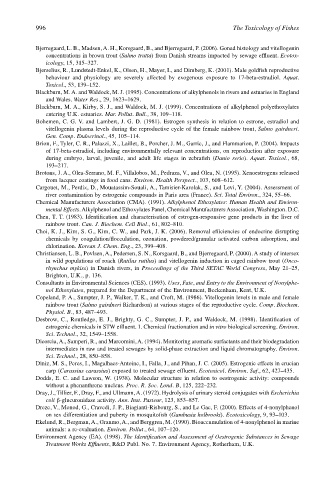Page 1016 - The Toxicology of Fishes
P. 1016
996 The Toxicology of Fishes
Bjerregaard, L. B., Madsen, A. H., Korsgaard, B., and Bjerregaard, P. (2006). Gonad histology and vitellogenin
concentrations in brown trout (Salmo trutta) from Danish streams impacted by sewage effluent. Ecotox-
icology, 15, 315–327.
Bjerselius, R., Lundstedt-Enkel, K., Olsen, H., Mayer, I., and Dimberg, K. (2001). Male goldfish reproductive
behaviour and physiology are severely affected by exogenous exposure to 17-beta-estradiol. Aquat.
Toxicol., 53, 139–152.
Blackburn, M. A. and Waldock, M. J. (1995). Concentrations of alkylphenols in rivers and estuaries in England
and Wales. Water Res., 29, 1623–1629.
Blackburn, M. A., Kirby, S. J., and Waldock, M. J. (1999). Concentrations of alkylphenol polyethoxylates
entering U.K. estuaries. Mar. Pollut. Bull., 38, 109–118.
Bohemen, C. G. V. and Lambert, J. G. D. (1981). Estrogen synthesis in relation to estrone, estradiol and
vitellogenin plasma levels during the reproductive cycle of the female rainbow trout, Salmo gairdneri.
Gen. Comp. Endocrinol., 45, 105–114.
Brion, F., Tyler, C. R., Palazzi, X., Laillet, B., Porcher, J. M., Garric, J., and Flammarion, P. (2004). Impacts
of 17-beta-estradiol, including environmentally relevant concentrations, on reproduction after exposure
during embryo, larval, juvenile, and adult life stages in zebrafish (Danio rerio). Aquat. Toxicol., 68,
193–217.
Brotons, J. A., Olea-Serrano, M. F., Villalobos, M., Pedraza, V., and Olea, N. (1995). Xenoestrogens released
from lacquer coatings in food cans. Environ. Health Perspect., 103, 608–612.
Cargouet, M., Perdiz, D., Mouatassim-Souali, A., Tamisier-Karolak, S., and Levi, Y. (2004). Assessment of
river contamination by estrogenic compounds in Paris area (France). Sci. Total Environ., 324, 55–66.
Chemical Manufacturers Association (CMA). (1991). Alkylphenol Ethoxylates: Human Health and Environ-
mental Effects. Alkylphenol and Ethoxylates Panel, Chemical Manufacturers Association, Washington. D.C.
Chen, T. T. (1983). Identification and characterisation of estrogen-responsive gene products in the liver of
rainbow trout. Can. J. Biochem. Cell Biol., 61, 802–810.
Choi, K. J., Kim, S. G., Kim, C. W., and Park, J. K. (2006). Removal efficiencies of endocrine disrupting
chemicals by coagulation/flocculation, ozonation, powdered/granular activated carbon adsorption, and
chlorination. Korean J. Chem. Eng., 23, 399–408.
Christiansen, L. B., Povlsen, A., Pedersen, S. N., Korsgaard, B., and Bjerregaard, P. (2000). A study of intersex
in wild populations of roach (Rutilus rutilus) and vitellogenin induction in caged rainbow trout (Onco-
rhynchus mykiss) in Danish rivers, in Proceedings of the Third SETAC World Congress, May 21–25,
Brighton, U.K., p. 136.
Consultants in Environmental Sciences (CES). (1993). Uses, Fate, and Entry to the Environment of Nonylphe-
nol Ethoxylates, prepared for the Department of the Environment, Beckenham, Kent, U.K.
Copeland, P. A., Sumpter, J. P., Walker, T. K., and Croft, M. (1986). Vitellogenin levels in male and female
rainbow trout (Salmo gairdneri Richardson) at various stages of the reproductive cycle. Comp. Biochem.
Physiol. B., 83, 487–493.
Desbrow, C., Routledge, E. J., Brighty, G. C., Sumpter, J. P., and Waldock, M. (1998). Identification of
estrogenic chemicals in STW effluent. 1. Chemical fractionation and in vitro biological screening. Environ.
Sci. Technol., 32, 1549–1558.
Dicorcia, A., Samperi, R., and Marcomini, A. (1994). Monitoring aromatic surfactants and their biodegradation
intermediates in raw and treated sewages by solid-phase extraction and liquid chromatography. Environ.
Sci. Technol., 28, 850–858.
Diniz, M. S., Peres, I., Magalhaes-Antoine, I., Falla, J., and Pihan, J. C. (2005). Estrogenic effects in crucian
carp (Carassius carassius) exposed to treated sewage effluent. Ecotoxicol. Environ. Saf., 62, 427–435.
Dodds, E. C. and Lawson, W. (1938). Molecular structure in relation to oestrogenic activity: compounds
without a phenanthrene nucleus. Proc. R. Soc. Lond. B, 125, 222–232.
Dray, J., Tillier, F., Dray, F., and Ullmann, A. (1972). Hydrolysis of urinary steroid conjugates with Escherichia
coli β-glucuronidase activity. Ann. Inst. Pasteur, 123, 853–857.
Dreze, V., Monod, G., Cravedi, J. P., Biagianti-Risbourg, S., and Le Gac, F. (2000). Effects of 4-nonylphenol
on sex differentiation and puberty in mosquitofish (Gambusia holbrooki). Ecotoxicology, 9, 93–103.
Ekelund, R., Bergman, A., Granmo, A., and Berggren, M. (1990). Bioaccumulation of 4-nonylphenol in marine
animals: a re-evaluation. Environ. Pollut., 64, 107–120.
Environment Agency (EA). (1998). The Identification and Assessment of Oestrogenic Substances in Sewage
Treatment Works Effluents, R&D Publ. No. 7. Environment Agency, Rotherham, U.K.

